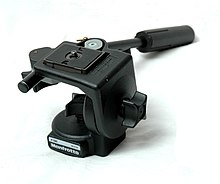2-way head
A two-way tilting head , also known as a video tilting head or video head , refers to tripod heads that can be moved in two axes. Two-way tilt heads are mainly used in the video and film sector. They differ from three-way tilt heads in terms of design and area of application and should not be understood as an economy version of a three-way tilt head.
properties
Use in the film sector places special demands on a tripod head. There is no so-called tilt or lateral tilt function with pure video tripods. Photographers need the tilt function to quickly switch between portrait and landscape format. This is not necessary for video recordings, as the television and screens are oriented towards landscape format. A tilt function is therefore superfluous and you can concentrate on the two remaining axes.
With a video head, it must be possible to carry out smooth and smooth swiveling movements. Video heads usually have a longer lever arm that enables sensitive guidance. Photo tripods often have short levers, which also serve as adjusting or locking screws. In the case of video tripods, the video arm often only serves to guide the camera and, if necessary, to accommodate electronic control elements for the camera itself (see Control-L ).
Video tripods are usually specially stored. So-called fluid systems are mostly used. With fluid heads, the axis slides on a thin grease or oil film. Disturbing vibrations or even rotating noises are minimized. Different camera weights and demands on the pan speed require an adaptation of the rotation ability. Video heads therefore have, in addition to the pure locking function, an adjustment option for the rotational resistance.
A trouble-free start of the movement is also necessary for the perfect swivel function. If there is a jolt at the beginning of the movement, which can be caused, for example, by the adhesive bonding of the sliding surfaces and unsuitable lubricant, the image quality suffers due to the perceptible image jerking. Some swivel systems do not rely on sliding surfaces or fluid systems, but on gear drives that set a flywheel in motion. This avoids the starting jolt, and at the same time a more uniform movement speed can be achieved over the entire pivoting range . In addition, an electric drive can also be implemented in these systems. By programming start, stop and speed, reproducible pans can also be realized with professional systems.
Professional film cameras are much heavier than professional photo cameras. A weight of 4 kg and more is not uncommon for film cameras. For example, the Canon XL H1A weighs around 4 kg. For this reason, video tilters are often larger and heavier than photo tilters so that they can better carry the heavier weights of film cameras.
Two-way tilt head for telephotography
Two-way tilt heads are used for telephotography, especially by nature photographers. There are three different types:
- medium-sized fluid head from the film sector
- Tele pointer (Teleschwenkbügel)
- Ball tilting head with panoramic axis and partially locked tilting axes, so that only forward and backward tilting is possible
All three pan heads listed enable exact dragging with action photography and prevent the lens-camera unit from tipping sideways on the tripod.
